Will the Sea Cucumber Industry Sink or Swim? A Look at Its Future Amidst Overfishing Concerns
The Vacuum Cleaners of the Sea
Sea cucumbers play a vital role in marine ecosystems and are an important fishery. Known as the ‘vacuum cleaners’ of the sea, they help maintain ocean floor health by recycling nutrients. These sea creatures break down detritus and improve sediment quality. The result is the boosting of marine biodiversity and productivity. Local sea cucumber researcher, Doctor Arlenie Rogers, Assistant Professor at the University of Belize, explained, “They are eating sediment from the seafloor, and when they excrete that, it is sand. So they oxygenate the seafloor as well. So that is the benefit of providing for the environment.”
Dr. Rogers explained that sea cucumbers serve as homes for different marine organisms like worms, snails, clams, algae, and microorganisms. Besides their role in the ecosystem, sea cucumbers are also important to humans, especially in many Asian countries where they are used for medicine and food. “They also provide other benefits, like they use them to make shampoos and cosmetics,” Dr. Rogers added.
Sea cucumbers are in high demand in global markets, especially in Asia, for their culinary and medicinal uses. They also provide livelihoods for many coastal communities, including those in Belize. The sea cucumber industry is “big business” and “millions of dollars,” according to what Collet Area Representative Patrick Faber told the House of Representatives on July 2, 2021. Minister of the Blue Economy, Abner “Andre” Perez agreed. He said, “Sea cucumber is something very lucrative, as we all know.”
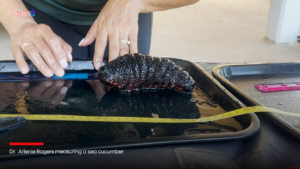
It is also known that they are vital to ocean ecosystems. They act as natural recyclers of nutrients. However, global overharvesting, driven by high demand in East Asia, threatens their survival, including in Belize’s waters. Despite the importance of this fishery, Belize’s track record of poorly managed stock assessments, similar to its handling of lobster and conch, raises concerns about the future of sea cucumbers. Without better data and stronger management, Belize risks overexploiting yet another critical marine resource.
There are over 100 species of sea cucumber fished in more than 70 countries, making them increasingly vulnerable to overexploitation. Many fisheries follow boom-and-bust cycles, with catches rising and then quickly declining due to overfishing. Since the 1990s, sea cucumber fisheries have become global, with new fisheries expanding much faster than in previous decades. Overfishing has caused population declines in 81% of these fisheries, with smaller body sizes being harvested and a shift from high- to low-value species. Many fisheries lack regulation, and illegal catches are widespread.
Population Crash
The rise and fall of the sea cucumber fishery, which experienced rapid growth followed by a swift decline, serves as a cautionary tale. Former Minister for Fisheries, Forestry, the Environment, and Sustainable Development, Dr. Omar Figueroa, explained why the decision was made to place a moratorium on sea cucumber harvesting. He said, “The data that we had in front of us was really pointing to a population crash when it comes to sea cucumbers.”
The fishery was not opened in 2017-2020 as the 2017 stock assessments showed declining stocks.
Sea cucumber fishing in Belize, though practiced for over two decades, became formally regulated in 2009 with the passing of Statutory Instrument 67, which introduced a closed season and limited licensing for the industry. Since then, licenses for sea cucumber harvesting have fluctuated between 70 and 80 permits annually, with quotas determined by an annual survey conducted by the Belize Fisheries Department. Initially, fishers received $3.50 BZD per pound of sea cucumber, but prices increased to $6.00 BZD per pound as demand grew. Some sea cucumbers can weigh as little as 1.6 oz.
In 2016, new regulations were introduced, including size limits, gutted weight specifications, fishing hours, and managed access requirements.
Further amendments in 2022 aimed to protect the fishery, with additional measures such as safeguarding spawning months, increasing size limits, and designating specific landing sites determined by the Fisheries Administrator. Despite its small scale, however, the sea cucumber fishery has gained significant attention from both buyers and fishers.
The Reopening of the New Sea Cucumber Season and the Impacts on Fishers

The Belize Sea Cucumber industry reopened on September 1, 2024, and is expected to close on January 31, 2025, or when the catch quota is realized. According to the Belize Fisheries Department, the only species of sea cucumber that will be permitted to be harvested is the Donkey Dung sea cucumber. The established quota is estimated at 175,000 lbs., or about 35,000 sea cucumbers. The legal size limit (minimum) is 16 cm in length. The gutted weight price (minimum) is BZD $5.00 per pound. The Department published the list of approved exporters: Rio Grande Fisherman Cooperative Society Limited, Rosendo Cassanova, Belize Ocean Catch Limited, and Zhang Imports.
In 2022, Belize’s sea cucumber fishery remained closed while awaiting the results of a stock assessment, which was completed in March 2023 by the Belize Fisheries Department in collaboration with the University of Belize. The “Commercial Sea Cucumber Stock Assessment to Determine Sustainable Quotas in Belize” report was produced. According to the report, the assessment focused on four fishing areas: Area 3 (covering the waters around the Cayes near the Placencia Peninsula and Placencia Lagoon), Area 5 (which includes the Port Honduras Marine Reserve), Area 6 (Turneffe Atoll), Area 7 (Lighthouse Reef Atoll), and Area 8 (Glover’s Reef Atoll). These are the areas where sea cucumber populations are most concentrated.
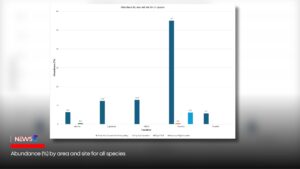
The survey gathered information on sea cucumber species, habitats, and depths using stratified random sampling at 22 stations with 81 sections, each 100 meters long and 4 meters wide. The most frequently found species were Florida sea cucumber, donkey dung, and chocolate chip cucumber, with Florida sea cucumber and donkey dung being the most abundant, particularly in Placencia Lagoon and surrounding islands. The assessment estimated a total population of 1.99 million Florida sea cucumber and donkey dung (equivalent to 249,8000 lbs of biomass) and 103,861 lbs of chocolate chip cucumber (103,800 lbs). To ensure sustainability, the annual harvest quota was set at a limit of an estimated 175,000 lbs for Florida sea cucumber and donkey dung. This quota is designed to balance the economic benefits of the fishery with the long-term health of sea cucumber populations.
In Belize, sea cucumber fishing is an important way to reduce pressure on other commercial fish species and provide additional income for local fishers. The report found, for example, that in the 2010-2011 period, income from sea cucumber fishing was reported to be 154 times higher than the minimum wage in Belize, which was $3.50 BZD at the time.
From 2009 to 2016, the sea cucumber fishery in Belize experienced varying production levels, often not meeting or slightly exceeding set quotas, with the fishery remaining closed from 2017 to 2020.
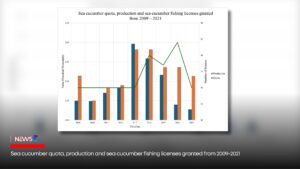
In 2021, the sea cucumber fishery was opened to all fishers with valid licenses to help them earn income lost during the COVID-19 pandemic. However, production was much lower than the set quota because many fishers were not fishing full-time, as COVID-19 remained a threat. Only two out of three exporters were buying sea cucumbers, and their purchases were minimal due to the uncertainties brought on by the pandemic.
Acting Fisheries Administrator Rigoberto Quintana explained how the 2024 season exporters were chosen.
We obtained minutes of 3 meetings (May 16, August 24, and October 13) that the Fisheries Council held at the Belize Fisheries Department Conference Room in Belize City. In attendance were key government officials, including CEO Kennedy Carrillo.
The sea cucumber industry was discussed in the context of it being an alternate livelihood for fishers. The government must expand protected areas to meet the Blue Bond agreement goals. But expanding the protected areas will potentially impact the livelihoods of fishers. And, to address this challenge, the ministry continues to explore alternative opportunities, including for fishers and their families to engage in sustainable activities like sea cucumber farming. According to the minutes, Felicia Cruz, Director of the Blue Economy Unit (BEU), said that the sea cucumber industry holds potential for great partnership and economic investment. While acknowledging concerns about wild stocks, Cruz pointed to promising opportunities in cultivating sea cucumber and other species such as stone crab, king crab, and seaweed. She noted that these resources are earmarked for potential mariculture development through public-private partnerships or investments. These are premium, high-value products, especially in Asian markets.
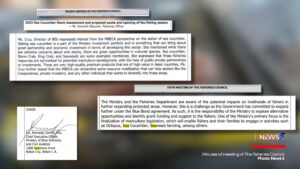
A Boom and Bust Industry?
The report also noted that while sea cucumber fisheries globally often experience periods of rapid growth followed by declines, it is crucial to apply precautionary measures and conduct stock assessments to ensure the long-term survival of these species. When asked how to ensure that the industry remains sustainable, Quintana said, “Well, the quota system that we have put in place, I think that will ensure that we only fish sustainably within the maximum sustainable yields.” According to Quintana, buyers will be required to record that data from fishers so they can track what is coming into the plant and what is being exported.
Renowned fisheries expert and principal investigator for Sea Around Us, Dr. Daniel Pauly, warns that sea cucumbers are extremely fragile. “A fishery for sea cucumber lasts about three, four years. And then there’s no more because the sea cucumbers apparently need to be like, let’s call it a herd. They need to be close to each other and the dense, the dense aggregation.”
Between 2011 and 2021, a study documented 97 incidents of sea cucumber crime in Mexico. This resulted in the seizure of over 100 metric tonnes of sea cucumbers by Mexican and U.S. authorities, valued at nearly $29.55 million. These incidents led to 125 arrests. In one major case in 2014, 34 metric tonnes of illegally caught sea cucumbers were seized on the Campeche Bank, while nearly 42 metric tonnes were confiscated by Mexico’s Navy between 2007 and 2016. The illegal sea cucumber trade in Mexico is extensive, with estimates suggesting that over 70% of the trade is unlawful. Authorities face significant challenges in tracking the amount of sea cucumbers being transported by land, sea, and air. In a striking 2018 U.S. case, two men tied to Joaquín “El Chapo” Guzmán’s Sinaloa cartel were convicted for using fake seafood companies to launder drug profits by disguising narcotics shipments, including cocaine and fentanyl, as sea cucumbers. This operation, which generated over $19 million between 2013 and 2015, resulted in the indictment of 15 conspirators and the seizure of over $5 million worth of narcotics.
Let’s take a look at what happened to the Galápagos sea cucumber fishery. It was once highly profitable but collapsed in the early 2000s due to overfishing. A 5-year fishing ban (2016–2021) was implemented to help the population recover, but it has not been successful. Despite management efforts relying on population density as a key indicator for opening or closing the fishery, the species continues to be overexploited.
A 2020 study published in Frontiers in Marine Science applied a stock-production model to estimate critical population parameters for the first time. It revealed that the current management approach has failed for over a decade. The study recommends extending the fishing ban and using more reliable indicators like biomass and fishing mortality ratios to better manage the fishery. Without these changes, the fishery is unlikely to recover by 2030.
During a phone interview with Mario Salazar, maritime fisheries inspector in the Directorate of Fisheries and Aquaculture in the Ministry of Agriculture, Livestock, and Food in Guatemala, he revealed that “we did an analysis on the state of the sea cucumber fishery. And yes, we found out some Belizean groups came to fish here because sea cucumber can be exported (in Belize) but not in Guatemala.”
According to Dr. Pauly, most sea cucumber fisheries are inherently unsustainable. While they can generate substantial profits, this wealth often benefits only the fleet owners, particularly those from Taiwan and elsewhere in East Asia, rather than local communities. He stressed that the sea cucumber industry does not follow a “boom and bust” pattern because there is no cyclical recovery—once depleted, they do not return.
To ensure sustainable fisheries in Belize, Dr. Pauly suggested that available funds should be directed towards providing subsidies or paying monthly salaries during the fishing season. He stressed that the true goal should be high, sustainable catches rather than just pursuing sustainability alone.
A lesson from Jamaica
Dr. Alvaro Hernandez is a fisheries specialist. His focus is on sedentary resources such as sea cucumbers and lobsters—species that depend on the seabed. He was hired by the Food and Agriculture Organization to conduct a technical study of the sea cucumber industry in Jamaica. It is titled, “Capacity-building in resource assessment and management of the Jamaican Sea Cucumber fishery and potential for aquaculture development.” The study began in 2015. According to the report, Jamaica views its marine resources as crucial for national development and food security.
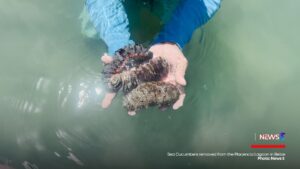
Sea cucumbers, though not traditionally consumed by Jamaicans, are gaining attention from locals due to rising global demand. Jamaican commercial entities are exploiting sea cucumber stocks for export, but there is limited information on stock levels, fishing pressure, and export values. In response, the country’s Ministry of Agriculture and Fisheries initiated a project to enhance the Fisheries Division’s capacity for sustainable sea cucumber management. The project included two field surveys, training for local fisheries managers and fishers in survey design and diving, and the application of new data analysis techniques. A preliminary stock assessment was completed and used to develop a management plan in consultation with stakeholders. A desktop study was conducted to assess the potential for developing sea cucumber aquaculture in Jamaica. It covered key areas such as broodstock management, spawning techniques, hatchery methods, grow-out, harvesting, and restocking. The study also offered insights into selecting suitable locations and outlined the initial experiments needed to explore the feasibility of establishing sea cucumber farming in the region. These efforts aim to establish a sustainable management framework for sea cucumbers, supporting the social and economic sustainability of local communities. The Ministry has indicated that the findings and management plan will be used to guide future decisions on the sea cucumber fishery.
According to Dr. Hernandez, sea cucumbers are considered an underutilised species with potential for development, but there is currently insufficient technical expertise for their assessment, management, and monitoring in Jamaica. The high export demand is driving poorly regulated harvesting, which risks overexploitation and collapse of the fishery. He said it is crucial for the Jamaican government and stakeholders to enhance their capacity to manage this fishery effectively and ensure its sustainability.
Dr. Hernandez’s report found that sustainable sea cucumber resources can foster a viable fishery that supports social and economic sustainability. He said that the development of this fishery also aligns with a human rights-based approach. Training provided to fisheries managers and fishers in field diving surveys, stock assessment, and management planning has built the necessary capacity and technology for ongoing sustainable practices. According to Dr. Hernandez, the project also prioritised gender equity by involving both male and female stakeholders, considering their distinct roles in the fishery.
Microplastics in Sea Cucumbers
In 2021, Dr. Rogers, along with associates, published a study showing that micro- and macroplastics are present in the digestive tract of sea cucumbers in the Placencia Lagoon.
The study found that microplastics are growing pollutant in our oceans. While it’s been documented that many marine animals ingest microplastics, there hasn’t been much research on sea cucumbers, especially in the Caribbean. In this study, microplastics in the gastrointestinal tract of the Florida sea cucumber, which was collected from Placencia Lagoon, which is near a busy tourist and fishing community, where solid waste is often dumped directly into the sea cucumber’s habitat.
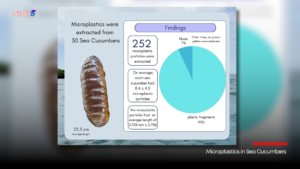
According to Dr. Rogers, these findings raise concerns about the potential chemical effects of these plastics on human health, particularly since sea cucumber intestines are considered a delicacy in some Asian countries. Important to note is that Belize does not currently export sea cucumber intestines.
A Lot Is At Risk
The decision to reopen Belize’s sea cucumber fishery in 2024 hinges on optimistic stock assessments, but the risks tied to past overexploitation and lack of transparency remain pressing concerns. The sea cucumber fishery’s history is a stark warning of what unchecked harvesting can lead to. While the introduction of regulated quotas, species restrictions, and size limits is encouraging, it is vital that these measures are enforced effectively. Collaboration among government bodies, fisheries experts, and local communities is essential to prevent a repeat of past mistakes. Additionally, new, invisible threats like microplastics pose unprecedented risks to marine ecosystems. Vigilant oversight and adaptive management will be key to navigating these uncertainties and ensuring a sustainable future for Belize’s marine resources.
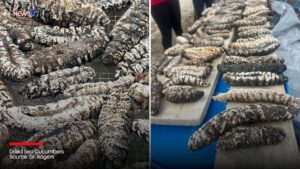





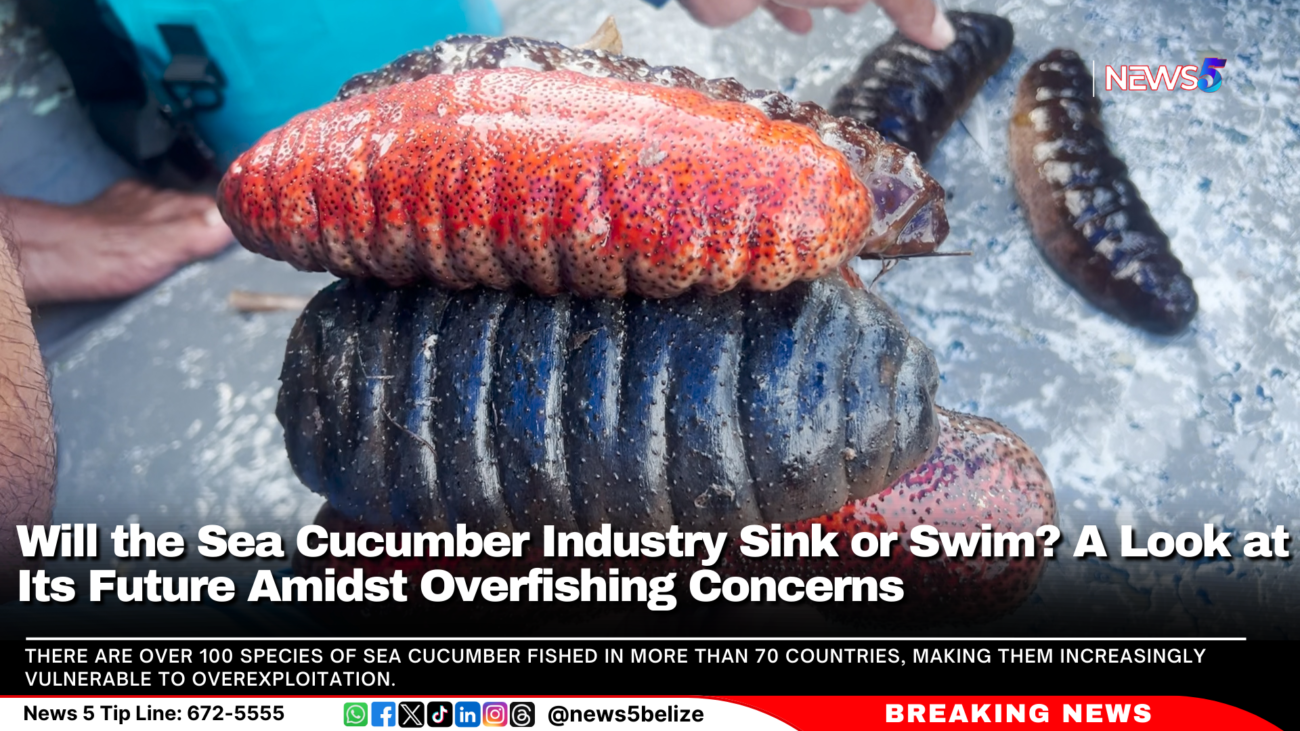

Facebook Comments